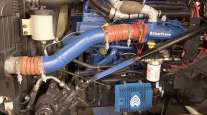Bloomberg News
Carbon Deal Targets Pipeline Seeking to Tackle Ethanol Emissions

[Stay on top of transportation news: Get TTNews in your inbox.]
A project to build a giant pipeline to remove carbon produced by the corn-based ethanol industry struck its first agreement to sell carbon-removal credits, part of a broader push to improve the green credentials of the fuel.
Summit Carbon Solutions, which is building the $5.5 billion pipeline through the heart of America’s Corn Belt, said it will sell credits valued at up to $30 million to NextGen CDR Facility, a joint venture of Japanese conglomerate Mitsubishi Corp. and climate consultancy South Pole.
Together with two other deals that the joint venture announced April 26, the transactions equal a quarter of all certified carbon removals to date, according to NextGen. Specific prices weren’t disclosed.
The corn-based ethanol industry, which has long fought claims from some opponents that the biofuel is worse for the planet than gasoline, is ramping up efforts to be more competitive in a rapidly shifting energy economy. Low-carbon fuel markets like California, as well as federal government incentives, are motivating producers to seek ways to hit net-zero or even negative carbon emissions.

Mike Furst of Volvo Trucks North America discusses a dealer-managed service plan that is paired with enhanced connectivity to cover all fleet preventative maintenance. Hear the program above and at RoadSigns.TTNews.com.
For Ames, Iowa-based Summit, the deal is part of its plan to monetize the potential environmental benefits of the project, which it hopes to have up and running by the first half of 2025 to tap potentially lucrative U.S. tax incentives. The firm says it will be the world’s largest carbon removal project, able to capture, transport and securely store up to 18 million tons of emissions a year from ethanol plants and other emitters. That’s the equivalent of about 4 million gasoline-powered cars.
The pipeline has more than two-thirds of landowner approvals needed for its route across five U.S. Midwestern states, though it still faces opposition from environmentalists and some farmers citing concerns over safety and property rights. Supporters say the pipeline will ensure ethanol’s value in an increasingly crowded market for low-carbon fuels, boosting profits for biofuel producers and corn farmers.
“Carbon is the next great commodity,” Summit Carbon CEO Lee Blank said in an interview. “It’s the next frontier for agriculture.”
To have a chance at avoiding catastrophic climate shifts, scientists say that the world quickly needs to ramp up efforts to remove carbon from the air, especially in high-polluting industries like aviation and energy. A recent study showed that engineered approaches for carbon removal must increase by a factor of at least 1,300 by the middle of the century.
While carbon removal technologies remain controversial — some critics argue the efforts are costly and serve to extend the life of fossil fuels — supporters say tax incentives in the U.S. Inflation Reduction Act are transformative enough that the technology is ready to take off.
Carbon is the next great commodity. It's the next frontier for agriculture.
Lee Blank, CEO of Summit Carbon Solutions
Image
The trio of deals that NextGen unveiled April 26 amounts to 193,125 metric tons of technological carbon removals. One is an agreement to buy carbon-removal credits from 1PointFive, a unit of Texas-based Occidental Petroleum Corp. that’s developing the world’s largest direct-air capture plant. It would remove carbon from the atmosphere and then pump it underground.
NextGen is seeking to secure more than 1 million tons of carbon removals by 2025 with captured emissions being stored by 2030 for more than a millennium. The average target price for NextGen’s portfolio is $200 a ton, according to Philip Moss, NextGen chairman and head of tech carbon removals at South Pole. The venture is backed by companies including UBS Group AG and Swiss Re, who have also agreed to buy credits.
While Moss acknowledged the skepticism around how carbon-removal methods are measured, he stressed the venture’s emphasis on transparency and third-party verification.
“We have a lot of confidence around the ability to gauge how much carbon we are actually taking out of the atmosphere and putting underground,” Moss said.
— With assistance from Michael Hirtzer and Kevin Crowley.
Want more news? Listen to today's daily briefing below or go here for more info:





